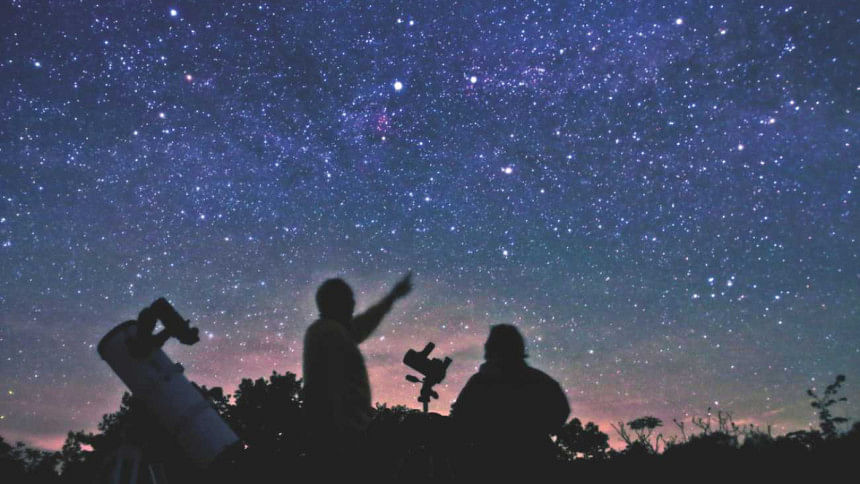How to Stargaze in Dhaka

Don't believe it? Well, think again. Urban stargazing might sound like an utterly ludicrous prospect, but as they say, nothing's impossible if you REALLY want it. Sure, we may no longer live in an era where our bare eyes could sight the aesthetic Milky Way at night – thanks to the lurid light pollution generated today - but it's also the age of mind-blowing technology and gadgets, some of which can aid in satisfying your starlust.
Bangladesh Astronomical Association is devoted to observing the cosmos straight from Dhaka. It hosts a free stargazing session every Friday, 4 p.m. to 8 p.m., provided the weather is suitable. You can even become a member by paying an annual fee of BDT 2,000. The science museum in Shyamoli also arranges a similar session on Saturdays and Sundays from dusk. The charge is only BDT 10. They have everything you need: telescopes and binoculars, experts who can tell you how to use them, all within a local observatory. Visit their website or Facebook page to get schedules.
If going out isn't your cup of tea and you want to watch wonders hidden in plain sight comfily from home, that's possible too. A pair of binoculars is all you need. They're more portable and maneuverable and give a more panoramic view compared to telescopes. You can invest in a telescope later if you want to pursue it as a major interest. Quality binoculars can be obtained for around BDT 20,000 from New Market, Science Laboratory, Stadium Market and several electronics stores throughout the city, whereas a telescope can cost you BDT 80000 or higher. It gets way lower if you can source it from countries like China or Singapore. Aperture of both binoculars and telescopes is key to good stargazing – the higher the aperture, the easier it is to spot fainter objects. Head to the shops at twilight, and test binoculars/telescopes to ensure that the view through is crisp before confirming purchase.
Done picking the ideal equipment? Now start inspecting weather reports for a calm, unclouded, non-moonlit night forecast. Once these conditions are affirmative, you're good to go! AccuWeather.com has a separate forecast for stargazing weather, how amazing is that? The winter skies hold more bright stars than any other season. Next, choose a spot with the lowest light interference. A high-rise rooftop places you above many impediments, including trees and street-level lighting. The night can get pretty chill (pun intended) - prepare yourself with a turtleneck sweater,a folding chair to sit on, a flask of hot cocoa or coffee (or both, mmmm) and a box of finger foods to make the most out it. You could even arrange a stargazing party with friends, allowing you to explore the firmament with an assortment of gadgets pooled by everyone involved. Give your eyes about twenty minutes to adjust to the darkness. The process could be initiated earlier by wearing sunglasses indoors a while before leaving, so that a gradual reduction of light ensues on your eyes. (Yes, it might be kamla to wear shades at night, but hey, you gotta do what you gotta do).
If you need some light to avoid stumbling in the darkness (or falling off the roof), get a flashlight with a red filter. Red light doesn't affect your eyes' ability to adjust to the dark unlike blue/white light. Look for the most luminous stars and worldwide spectacles like the Hunter constellation initially,and gradually move on to hazier ones. Brushing up on your astronomy knowledge adds tons to the experience. Try to obtain a fun glow-in-the-dark star chart if possible, or excellent apps like Starwalk could be utilized if your phone has a red night-shift mode.
There you go, every indispensable detail required for mission impossible. Have a stellar experience (sorry) and try not to undergo an existential crisis in the process.

 For all latest news, follow The Daily Star's Google News channel.
For all latest news, follow The Daily Star's Google News channel. 



Comments